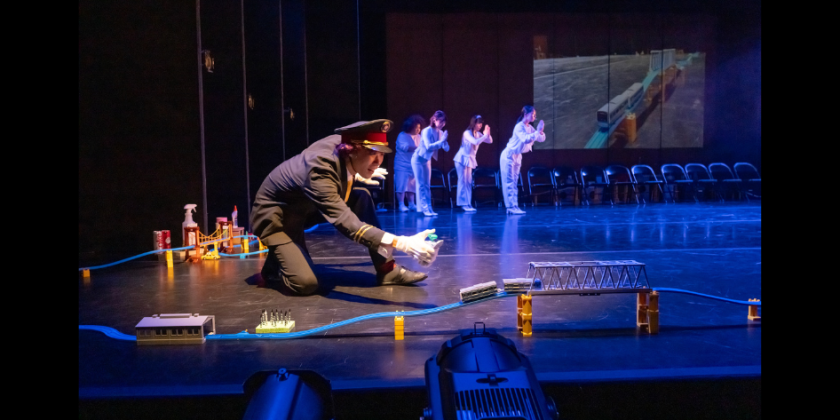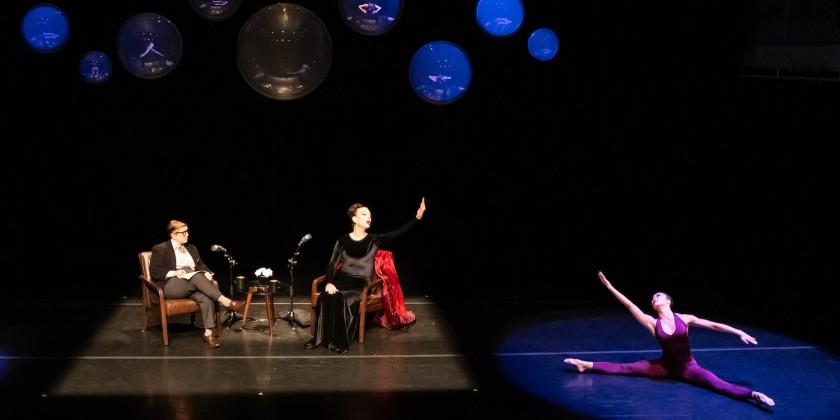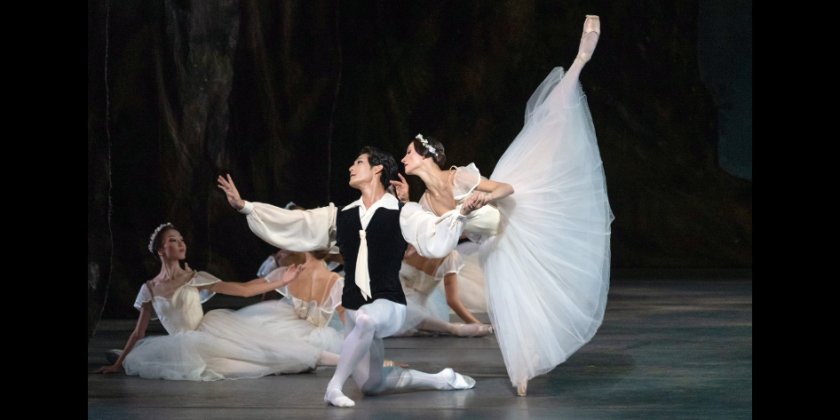Impressions of Stephen Petronio Company

Unveiling "Bloodlines" during its Thirtieth Anniversary Season
Stephen Petronio Company presents the inaugural season of Bloodlines,
featuring Merce Cunningham’s RainForest (1968)
The premiere of Stephen Petronio’s two-part work Locomotor/Non Locomotor
April 7–12, 2015, at The Joyce Theater
Pictured above: Melissa Toogood and Nicholas Sciscione in RainForest
Choreographer Stephen Petronio calls his latest project Bloodlines; and tellingly the name does not refer to a new creation, but to a schedule of revivals. An edgy artist sensitive to fluctuations in the Zeitgeist, Petronio may detect a change underway—a shift in the way modern dance companies operate.
Over the next five years, his Stephen Petronio Company will absorb historic pieces by other choreographers. He began the practice last week, at the Joyce Theater, by presenting Merce Cunningham’s seductive RainForest alongside his own novelty, Locomotor/Non Locomotor. Trisha Brown’s Glacial Decoy is on deck for next year.
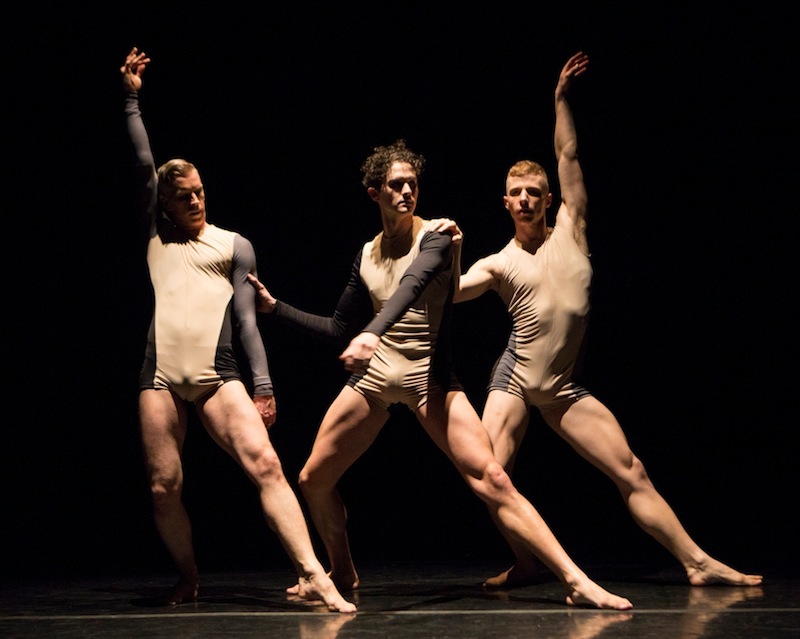
Gino Grenek, Joshua Tuason & Nicholas Sciscione in Non Locomotor; Photo: Yi-Chun Wu
With Bloodlines Petronio claims his rightful inheritance, emphasizing his credentials as an alumnus of Brown’s company. Yet the name he chose for this program may be even more revealing. Bloodlines sounds so dramatic. Does it also recall the years he spent soaking up the disaffected atmosphere of London during the 1990s, a toughening experience that distanced him from his pure-dance mentors? Or does the name reach further back in time to Martha Graham chewing on a blood-red cord, long before the denizens of Cunningham’s RainForest started browsing in their razor-cut leotards, and before the dancers in Glacial Decoy frolicked in angel robes? Today the distance between different generations of modern artists—between Graham and Cunningham, or Brown and Petronio—seems narrower than ever and of less concern than the pressures that threaten them all.
Graham’s death in 1991 and the pitched battle that erupted over copyrights to her works; the shocking dissolution of Cunningham’s company following his death in 2009; and the struggle of Brown’s company to survive her illness have all underscored what these artists have in common. They are all mortal, regardless of which generation they belong to, or how we classify their aesthetic. A few years of erosion have exposed the fragility of our modern dance establishment, which is still largely a network of separate companies like Petronio’s, each dedicated to a single choreographer’s vision. Yet the emergence of mixed-repertory troupes like Hubbard Street Dance Chicago, Cedar Lake and Aspen-Santa Fe Ballet has challenged the lone-choreographer model. So have mixed-repertory programs like the Fall for Dance Festival, established in 2004.
At the same time, major social changes—the dispersal of middle-class audiences to the suburbs, and the widening gulf between the rich and everybody else—are challenging our preconceptions, and altering the habits of modern artists. Facing economic straits, theater managers may prefer mixed repertory hoping it will appeal to a wider public; while young choreographers are postponing or foregoing a commitment to set up their own companies. While individualism remains central to the creation of modern dance, sharing resources may be essential to its survival. Without questioning Petronio’s reverence for Cunningham and Brown, we can see his decision to present RainForest as more than a noble gesture. Preservation and what environmentalists call “sustainability” may not have been 20th-century virtues, but they will be key to the 21st century; and modern artists, postmodern artists—or whatever they may call themselves eventually—should light the way into the future.
Cunningham has been on many people’s minds lately. His influence keeps resurfacing (this week the brilliant economy of Ulysses Dove’s Dancing on the Front Porch of Heaven, performed by the Dance Theatre of Harlem, recalled Dove’s apprenticeship in Cunningham’s studio). And we are beginning to digest, uneasily, the realization that as a community we are guilty of desertion.
Surely Petronio was thinking of Merce when he created Locomotor/Non Locomotor, a dance in two parts that Petronio completed this year. The piece has Cunningham’s extended lines and coolly rounded shapes, though its gestures are complicated and the dancers’ gruff energy threatens to become unruly. Maybe Petronio was also thinking of Lucinda Childs, whose 1979 piece Dance offered fleet, space-devouring movement; although the primary reference in Locomotor must be to Trisha Brown’s impulsive Watermotor of 1978.
Locomotor is larger in scale than either of those legacy dances, with the cast leaping in grands jetés and propelling themselves through the air with kicks. The movement is carefully aimed, as it would have to be since much of it runs backward at high speed beginning with a solo that Melissa Toogood dances. Sudden whorls and slices mark her trajectory like punctuation, and moments of stillness seem to reset the clock. Yet the direction is so insistent that a viewer may forget moving forward is the natural order of things. While this display of coordination is impressive, there’s something odd about a dance called Locomotor looping and rewinding—as if getting from place to place were less important than journeying backward. The piece is set to a kitchen-sink score by Clams Casino that moves from silence to tolling bells, and onward to keyboards and fearsome growls like lions roaring.
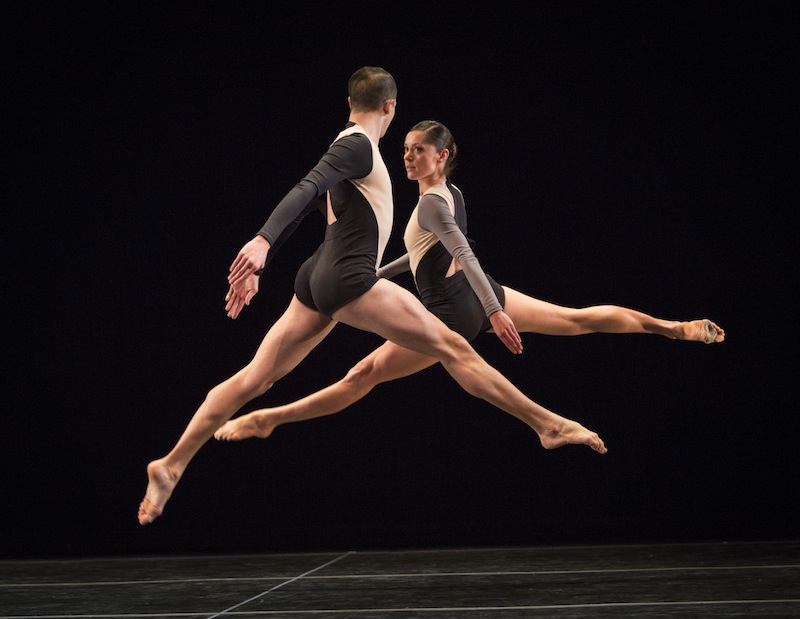
After driving fearlessly in reverse, Toogood is about to leave the stage when Joshua Tuason appears and standing side-by-side, half in the wings, they lock together. Somehow he changes her mind about leaving, and when the two of them back-peddle onto the scene they introduce a duet section with pairs of dancers curving around and past one another. The duets multiply, with pairs of dancers shooting onto the stage like curling streamers. Then, as the dance expands, nearly everyone falls in line for a final jog around.
After the duets, the dancers are free to move forward and to make connections, foreshadowed by a still moment when Jaqlin Medlock and Barrington Hinds touch hands. Their gesture seems innocent, until other dancers’ hands reveal the power to grasp and control. Seizing each other by the hands, two men develop a tortuous relationship. Hinds yanks Nicholas Sciscione onto his shoulder, and forces him to the floor. Left to his own devices, Sciscione flexes his hand and squeezes it between his thighs in a gesture that suggests both voluptuousness and pain. Locomotor is a plotless dance, but Petronio doesn’t mind telling us that keeping a tight grip on another person sometimes hurts. Later, the central figure in a trio seems caught and corralled, but despite mounting urgency Locomotor never seems to climax before the movement starts running backward again.
Non Locomotor, the pendant piece the choreographer added this season, is very different, although Petronio seems to develop one of his strategies in the opening dance. In a spare work like Locomotor, whether a dancer faces upstage or downstage can have outsize importance. As a woman emerges from the wings to join a pair of women who are already engaged, and dancing with their backs to us, the choreographer finesses the transition by having one of the pair—the woman who has become the central figure in the trio—turn to face us.
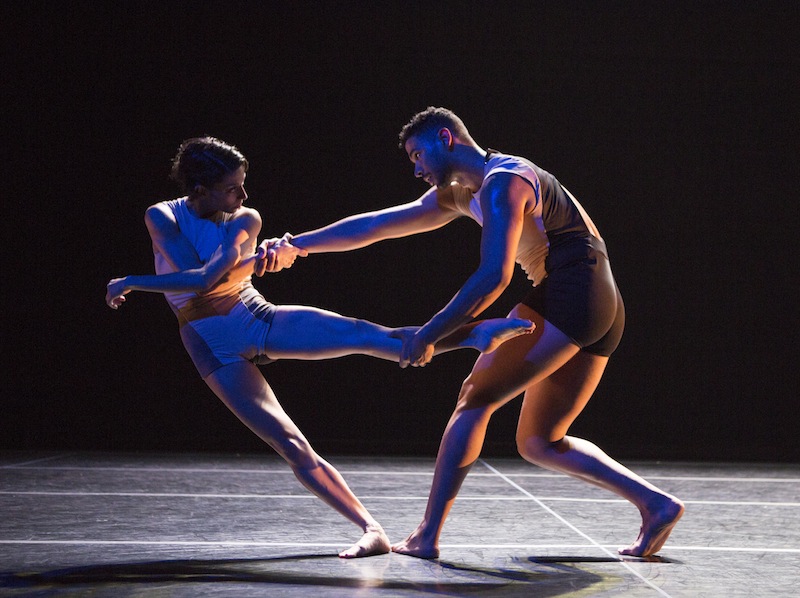
Davalois Fearon is that woman in the middle, and in Non Locomotor she’s the standout again, a bright figure in a turquoise-blue leotard, her movements placed in opposition to a drably costumed male ensemble. There’s much more to it, of course. Petronio gives Fearon mighty leaps, and he insists we notice the sharp rotations of her shoulder. Yet these dances downplay heroism. What seems to matter is the way choreographic patterns mesh together.
Despite their formal affinities, the rift between Locomotor/Non Locomotor, and RainForest is startling. While Petronio’s work appears controlled to the point of mechanization, Cunningham’s dance allows inflated Mylar pillows to drift haphazardly on and off the stage. Like tree leaves ruffled by the breeze, these balloon-like objects catch the light at random moments. They float into the audience, and, if they become a nuisance, viewers swat them out of the way, the sound of swats blending happily with the drip of David Tudor’s electronic score. Sitting in the theater, we are miraculously close to nature.
Yet this scenic element is only part of a larger scheme, in which Cunningham teases us with movement that may or may not be purposeful. Gino Grenek and Medlock are the “Adam and Eve” couple who begin the dance stretching, as if recently awakened. As they repeat their gestures, gradually they adjust themselves facing out and circling until they return to their original position. Ah, a circle! There’s something eminently reasonable about tracing a geometric figure in space. Similarly, when Tuason begins to teeter from side to side, it makes sense that at some point he will fall to earth—gravity, and all that. This much is reassuring.
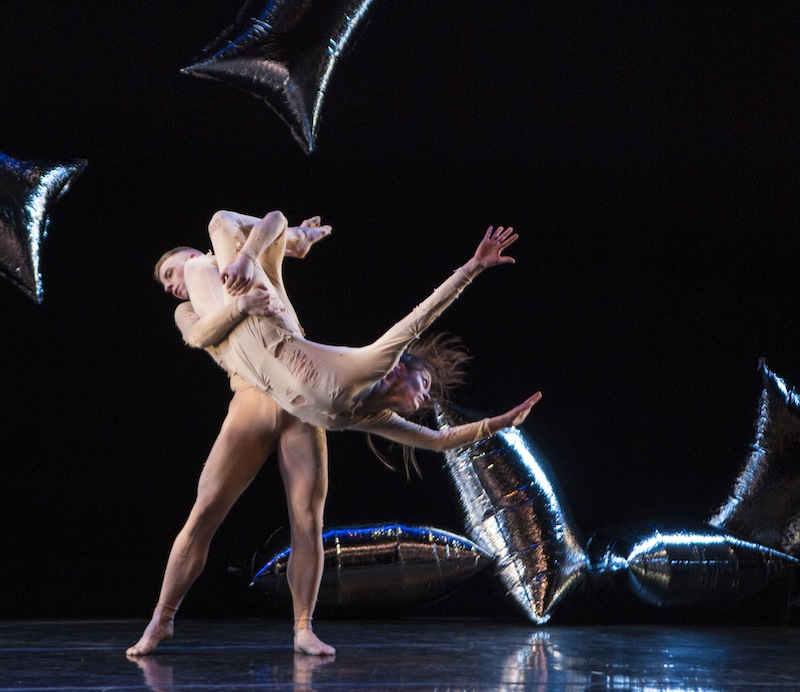
Yet there’s no way to explain why Sciscione remains motionless for so long, gazing into the distance, or why he suddenly begins to move. And can we trust ourselves to interpret what is happening when Medlock, who has been sitting with her head resting prettily against Grenek’s shoulder, abruptly leaves him to follow Sciscione? We feel the sudden clutch of jealousy—but does Grenek? And do we even really know, as Medlock trails after Sciscione apparently staring fascinated at his up-turned chin, that she is in fact following him, and that their moving bodies are connected in the way they appear to be? It would be just like Cunningham for one of them to stop and for the other one to continue, although that’s not what happens this time.
Watching RainForest we remain suspended between knowing and not knowing. Cunningham brilliantly cuts the ties of willfulness that anchor us to the earth, so like those pillows we can float—free, at last, of wanting and struggling. What a marvelous feeling!




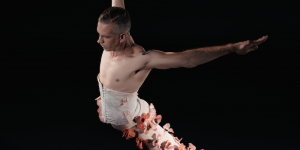
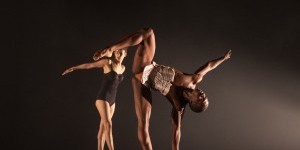

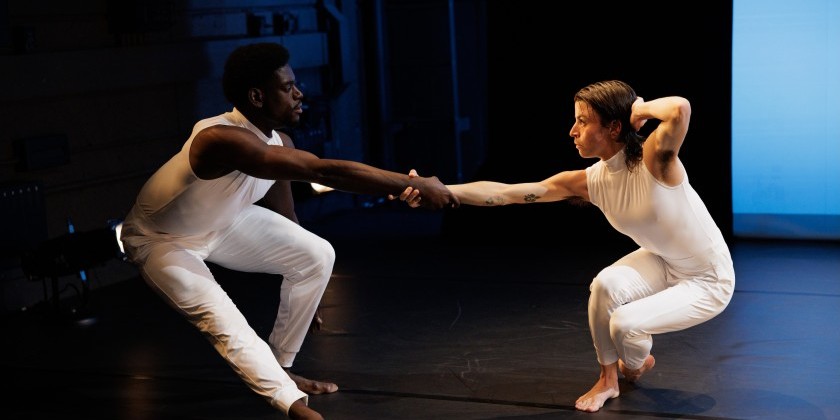

![IMPRESSIONS: Will Rawls' “[siccer]” at the Keith Haring Theatre at Performance Space New York](/images/features_large/20251119_WillRawls_siccer_PerformanceSpaceNY_WhitneyBrowne--55.jpg)
